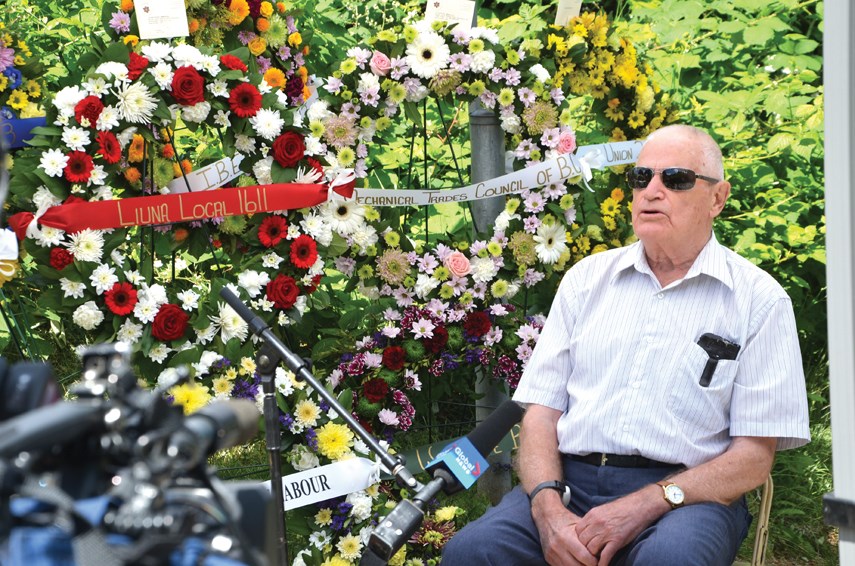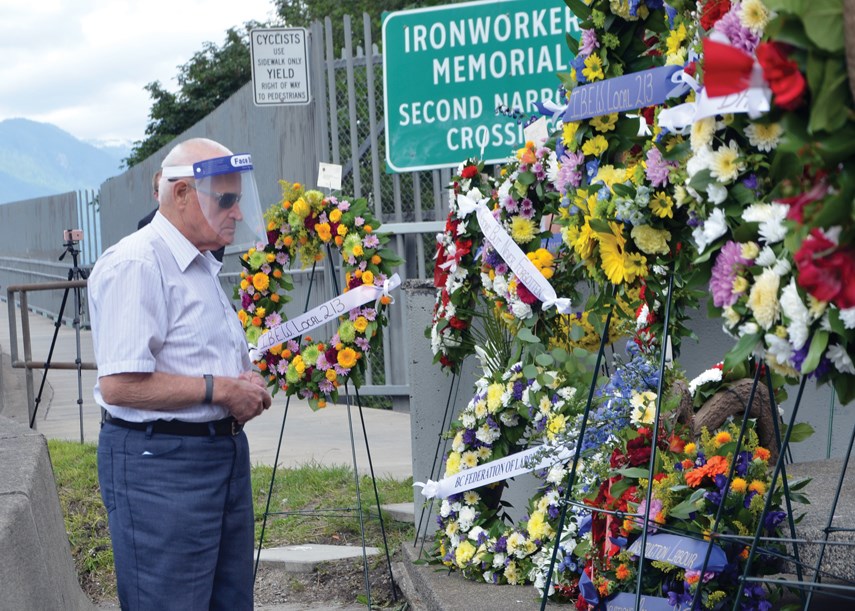The last living iron worker who survived the 1958 collapse of the Second Narrows Bridge is publicly sharing his story one final time.
After 62 years, 91-year-old Lucien Lessard made one last trip Wednesday to speak at the annual memorial service dedicated to the 19 men who died in B.C.’s worst ever industrial accident.
Lessard recalls the day being like any other, right up until the time they brought in one last steel beam.
“All of a sudden, we heard a very sharp noise,” he said.
The right side of the bridge was the first to go. The left side went a split second later, he recalls.
“I was lucky. I didn’t go down with the wreckage of steel. I fell directly off the side of the bridge, about 150 feet. I hit the water at extreme speed,” he said.
In those days, there were no nets, ropes or harnesses – only life jackets. Lessard’s life jacket slipped off as soon as he hit the water and he kept going down, right to the mud of the inlet floor.
He was disoriented but conscious. His femur was shattered and his arm was broken. He could see sunlight at the surface and vowed to make his way up.
“There was no air at the bottom of the ocean and the water did not taste very good,” he joked.
He found a floating plank to cling to while the current swept him away from the scene. Rescuers in a boat picked him up and got him to shore.
Other workers weren’t so lucky. Some were mangled in the steel. Others survived the fall but drowned, weighed down by their heavy tool belts. That day 18 men died, and one more, a diver, was killed a few days later while trying to recover a body.
Lessard spent the next four months at the North Vancouver hospital with his leg in traction.
When he was well enough, Lessard returned to work, now as a foreman and walking with the assistance of a cane.
It’s a story he’s told many, many times over the decades, often on June 17 at the annual memorial service held on the bridgehead.
That tradition began the year after the collapse. Lessard and a group of other survivors gathered for dinner at the Coconut Grove restaurant in Burnaby to plan it.
“We promised to never forget our brothers who lost their lives,” he said.
The Iron Workers Local 97 helped plan the ceremony, and the tradition grew. In 1994 the bridge was renamed the Ironworkers Memorial Second Narrows Crossing in honour of the workers who died during the construction.
The annual service has drawn upwards of 300 union members and dignitaries in the past but, thanks to COVID-19, it was a much smaller affair in 2020. And it nearly didn’t include Lessard.
The day after he moved into a seniors residence, the global pandemic was declared and he was unable to leave. With some persuasion and a strict safety plan, Lessard was given permission to come to today’s ceremony. There, he had one last important task – handing off an iron rose to an apprentice iron worker and, with it, the role of remembering those who died.
“All the other survivors are gone now. I’m the only one left,” he said. “Now I am going to relieve my responsibility and pass it to an apprentice worker. (She’s) young and can continue that for another 50 or 60 years. I’m not going to be here forever. I’ll be gone maybe in a year or two. I’m 91 now,” he said.
Apprentice Kelly Wolff jumped at the opportunity when the Iron Workers Local 97 asked if she would represent them.
“Especially as a female in the trade. You don’t see many of them nowadays so it’s exciting for that opportunity,” she said.
An investigation into the collapse found a math error resulted in a temporary support beam being cut too small to support the structure around it.
Wolff said the mistake and the lives it cost loom in the minds of iron workers today.
“It’s definitely something that reminds us of the safety factors that we want to put into our work every day,” she said. “It’s very sad but it’s something that we look back on and we want to strive to do better and make things safer for the next guy that comes onto the job site with us.”




